logb(x) = y, the exponent to raise b to to equal x:
by= x

logb n = p, the power p to raise the base b to to equal the number n:
bp= n
A logarithm (value) is an exponent. Convert a number to its exponent.
log10 1000 = 3, the exponent to raise 10 to to equal 1000: 103= 1000
log2 32 = 5, the exponent to raise 2 to to equal 32: 25= 32
log2 1/8 = -3, the exponent to raise 2 to to equal 1/8: 2-3= 1/8
"log" is the name of the function/operation. Could say f(x)=logb(x)
The parentheses are optional: logb x
NB. log x + 3 ≠ log(x+3)
You "take" a logarithm, like you "take" a square root.
Taking a logarithm is an operation on a number, like taking its square root is,
or raising it to a power.
Unlike other functions (e.g. linear, quadratic, exponential, rational),
a logarithm function doesn't have an algebraic expression
involving +-*/2√ defining what it does.
It does/means a certain operation on its argument.
It doesn't have a symbol like √ or +-*/p.
cf. sqrt()
Logarithm is both an operation (log 9) and a function (f(x)=log x),
like square root is
(√9 and f(x)=√x).
b is the base, any/every positive real number: b>0.
There are an infinite number of different logarithmic functions,
one for every positive real number.
But the two most common bases are 10 (common log: log without any base shown)
and e
(natural log: ln).
Caveat: sometimes someplaces log means natural log (e.g. WolframAlpha, Python).
"logarithm" literally means something unhelpful like "ratio number"

Recall the positive [integer] powers of 10:
100 = 1
101 = 10
102 = 100
103 = 1000
104 = 10000 ...
log10 x = y, the exponent to raise 10 to to equal x: 10y=x
log10 10000 = 4, the exponent to raise 10 to to equal 10000
log10 1000 = 3, the exponent to raise 10 to to equal 1000
log10 100 = 2, the exponent to raise 10 to to equal 100
log10 10 = 1, the exponent to raise 10 to to equal 10
log10 1 = 0, the exponent to raise 10 to to equal 1
For positive powers of 10, the log function tells how many 0's it has.
Or is approximately how many digits a positive integer has.
Recall the negative [integer] powers of 10:
10-1 = 1/10 = 0.1
10-2 = 1/100 = 0.01
10-3 = 1/1000 = 0.001 ...
log10 0.1 = -1, the exponent to raise 10 to to equal 0.1=1/10=10-1
log10 0.01 = -2, the exponent to raise 10 to to equal 0.01=1/100=10-2
Recall the powers of 2:
20 = 1
21 = 2
22 = 4
23 = 8
24 = 16
25 = 32 Powers of 2 worksheet
log2 x = y, the exponent to raise 2 to to equal x: 2y=x
log2 16 = 4, the exponent to raise 2 to to equal 16
log2 8 = 3, the exponent to raise 2 to to equal 8
log2 4 = 2, the exponent to raise 2 to to equal 4
log2 2 = 1, the exponent to raise 2 to to equal 2
log2 1 = 0, the exponent to raise 2 to to equal 1
log2 0.5 = -1, the exponent to raise 2 to to equal 0.5=1/2=2-1
log2 0.25 = -2, the exponent to raise 2 to to equal 0.25=1/4=2-2
Calculators have a log button (common log) and ln button (natural log).
MathPapa knows log and ln. Use a calculator or software to evaluate a log.
Some calculators have logb button.
Windows calculator: logyx button.
Desmos: Keypad | functions | Calculus | loga OR log Shift- to get into base area.
log 500 = 2.69897..., the (irrational) exponent to raise 10 to to equal 500: 102.69897≈500
log 50 = 1.69897..., the (irrational) exponent to raise 10 to to equal 50
log 5 = 0.69897..., the (irrational) exponent to raise 10 to to equal 5
log 1/5 = log 0.2 = -0.69897..., the (irrational) exponent to raise 10 to to equal 0.2
Log 2 worksheet
Natural log: ln The base is e
= loge ≈ log2.71828
We are not familiar with the powers of e... Use a calculator or software to
evaluate a ln.
ln e2 = 2, the exponent to raise e to to equal e2 duh e2≈7.3890561
ln 7.3890561≈2
ln e3 = 3, the exponent to raise e to to equal e3 e3≈20.085537
ln 20.085537≈3
ln 10≈2.3025851, the exponent to raise e to to equal 10. e2.3025851≈10
ln 100≈4.6051702, the exponent to raise e to to equal 100. e4.6051702≈100
ln 2≈0.6931, the exponent to raise e to to equal 2. e0.6931≈2
ln 1/2≈-0.6931, the exponent to raise e to to equal 1/2. e-0.6931≈1/2
"An artificial log is Duraflame."
Logarithmic functions are very slow growing.
NB. graph is not to scale:

Continuous and smooth. No wiggle, no extrema, no turning points.
Domain is (0,∞): no logs of negative numbers or 0. Range is R.
X-intercept at (1,0). Vertical asymptote is Y axis (x=0), so no y-intercept.
(b,1) is on the curve of f(x)=logb x
as is (1/b,-1)
logb a, where a<1, is negative. e.g. log 0.1=-1
NB. graph is not to scale:
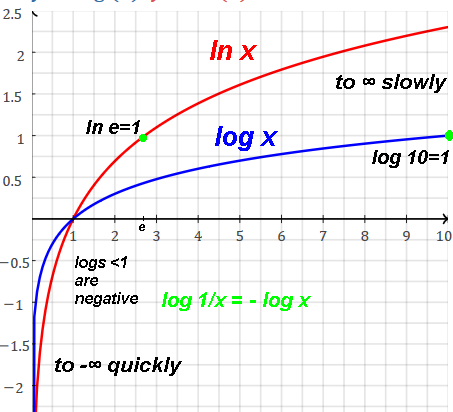
Worksheet log and ln
General logarithmic functions:
ƒ(x)= a·logbkx + c
or expression
Ex. 2 log 3x - 4
Always has a one-sided vertical asymptote. And restricted domain.
Log can make a big number small:
googol = 10100
log googol = 100
log log googol = log2 googol = 2
log log 1010 = 1
log log log googolplex = 2 googolplex=10googol
log 1/x = - log x
log ½ = - log 2
ln ½ = - ln 2 ≈ -0.6931
ln 1/e = - ln e = -1
Change of base formula.
logb x = logc x / logc b
Typically c is 10 or e: logb x = log x / log b = ln x / ln b
logold x = lognew x / lognew old
Useful if calculator can't do other logs (except common and natural).
Logs in different bases b and c differ by a constant factors logbc
and logcb.
Ex. log5 100 = log 100 / log 5 = ln 100 / ln 5
Ex. log2 100 = log 100 / log 2 = ln 100 / ln 2
Convert log to ln by multiplying by ~2.3: ln x ≈ 2.3 log x
Convert ln to log by dividing by ~2.3 or multiplying by 1/2.3=.434: log x ≈ .343 ln x
logb a = loga a / loga b = 1 / loga b
"Laws"/facts/properties of logarithms: to manipulate log expressions, to "expand" or to "compactify" a log expression.
logb b = 1 logb 1/b = -1
Every log:
log 1 = 0
Power rule:
log xn ↔ n log x
Exs. ln x4 = 4 ln x
ln 4x = x ln 4
Special case: log(1/x)= log x-1= - log x
Product rule:
log(xy) ↔ log x + log y
log of a product equals the sum of the logs of the factors.
Exs.
ln 4x = ln 4 + ln x
log 20 + log 5 = log 100
Quotient rule:
log(x/y) ↔ log x - log y
log of a quotient equals the difference of the logs.
Exs.
ln 4/x = ln 4 - ln x
log 100 - log 20 = log 5
Non-laws:
log(x+y)≠
log(x-y)≠
log(x)*log(y)≠
log(x)/log(y)≠
logb bx = x ln ex = x
logging an exponential leaves the exponent.
Exs.
log 103=3
log2 24 = 4
ln e5=5
blogb x = x eln x = x
exponentiating a log leaves the log's argument.
Exs.
10log 1000=1000
2log216=16
eln e5=e5
Exponent and logarithm are the inverse/reverse of each other,
they "undo" what the other did.
Logarithm is exponentiation "inside out".
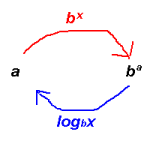
10x inverse is the common logarithm function: log x
bx inverse is the logarithm base b function: logb x
ex inverse is the natural logarithm function: ln x
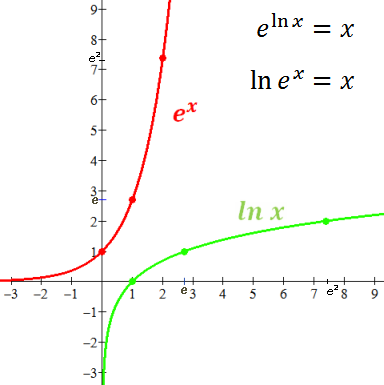
Like all inverse functions, they are reflections of each other over the y=x main diagonal.
ex has horizontal asymptote X axis (y=0).
ln x has vertical asymptote Y axis (x=0).
ex has y-intercept 1.
ln x has x-intercept 1.
Domain of ex is R. Range is (0,∞).
Domain of ln x is (0,∞). Range is R.
The exponential function, ex, is sometimes
denoted exp(x).
ln ex = ln(exp(x)) = x
eln x = exp(ln(x)) = x
Solving exponential or logarithmic equations.
If have an exponential (i.e. x is in the exponent) equation,
bx = a
take logs of both sides
(i.e. same operation to both sides), will "undo" the exponent:
bx = a
logb bx = logb a
do log on both sides
x = logb a
LHS becomes x, RHS is a number
Ex. 10x=3.4567 → log 10x= log 3.4567
→ x = log 3.4567 → x≈0.5386616
OR can use the power property: bx = a → x logb b = logb a
→ x = logb a [ logb b=1]
Ex. 10x=3.4567 → log 10x= log 3.4567
→ x log 10 = log 3.4567 → x≈0.5386616
If have a logarithmic (i.e. x is in a log) equation, logb x = a
raise the base b to both sides
(i.e. same operation to both sides), will "undo" the logarithm:
Recall: Exponent law/fact: blogba = a
Exs. 10log 1000 [= 103] = 1000
10log 50 [= 101.69897000] = 50
eln 100 [= e4.605170186] = 100
logb x = a
blogb x = ba raise both sides into base b
x = ba
Ex. log x=0.5386616 →
10log x = 100.5386616 →
x = 3.456699
Beware the extraneous solution.
Uses of logarithms:
--solve exponential equations.
--some scales are logarithmic: pH, decibels (sound), Richter earthquake (fury), star magnitude,
Moore's Law.
To accommodate the large ranges. A line represents exponential growth.
--log scale graph paper.
Elements
Earthquakes
--historical: ease some calculations (when no calculator):
multiplication of large factors turned into addition of the logs of the factors,
(division turned into subtraction of the logs of the dividend and divisor):
123456789*987654321 = log(123456789) + log(987654321)
≈8.09 + 8.98 = 17.07
10^17.07 ≈ 117,489,755,493,952,954
NB. log(117,489,755,493,952,954) ≈ 17.07
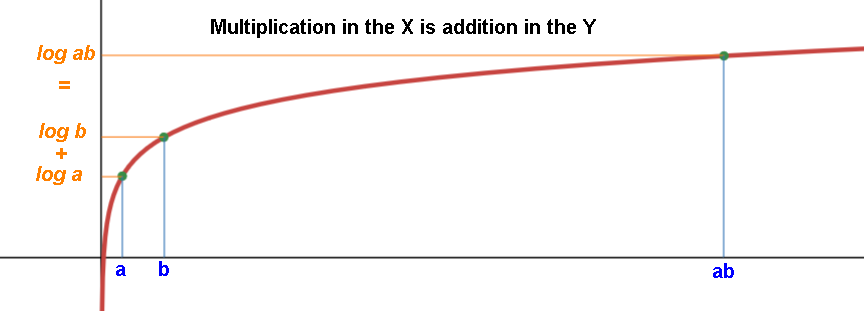
--Basis of the slide rule.
--List of logs: log tables at the back of textbooks.
Derivative of ln: (ln x)' = 1/x
rate of change of ln x at x is 1/x
Integral of ln: ∫ln(x) = x ln(x)- x = x(ln x -1)
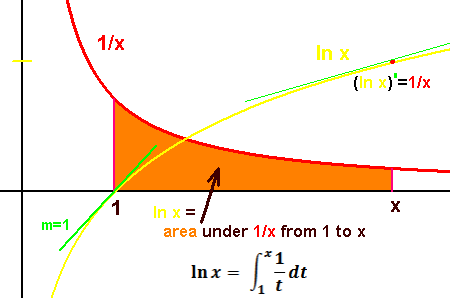
Derivative of logb: (log bx)' = 1 / (x ln b)
Derivative of general logarithm function: (a·logbcx + d)' = a / (x ln b)
Integral of logb: ∫log bx = x(ln x - 1) / ln b
Integral of general logarithm function: ∫a·logbcx + d =
x(a ln cx - a + d ln b) / ln b
"Naturalness": slope of tangent line to ln(x) at (1,0) is 1.
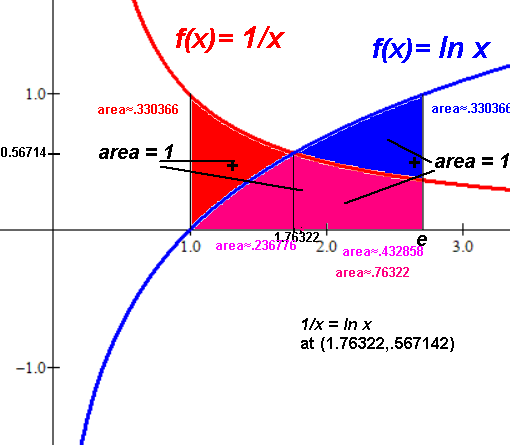
bx=eln(b)x
2x=eln(2)x=e.6931x
3x=eln(3)x=e1.098x
eax=(ea)x
Doubling time of continuous growth:
FV=Pert if FV=2P then 2P=Pert
2=ert ln 2 = rt

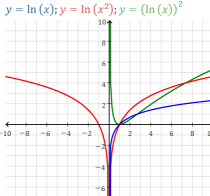
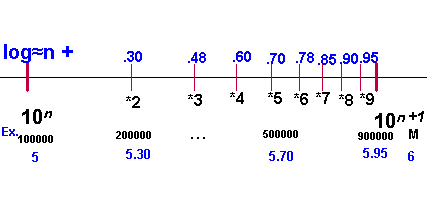
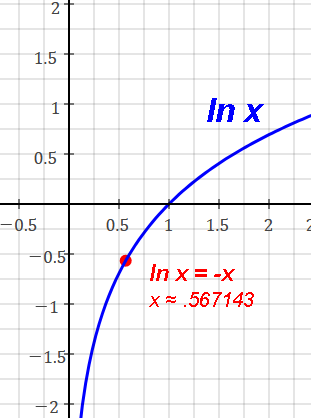
ln -2 = ln 2 + πi